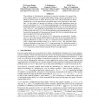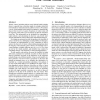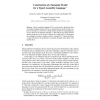191 search results - page 36 / 39 » Second-Order Programs with Preconditions |
NIPS
2007
13 years 8 months ago
2007
The problem of obtaining the maximum a posteriori estimate of a general discrete random field (i.e. a random field defined using a finite and discrete set of labels) is known ...
ASPLOS
2006
ACM
14 years 1 months ago
2006
ACM
Worms, viruses, and other malware can be ticking bombs counting down to a specific time, when they might, for example, delete files or download new instructions from a public we...
VMCAI
2004
Springer
14 years 22 days ago
2004
Springer
Typed Assembly Languages (TALs) can be used to validate the safety of assembly-language programs. However, typing rules are usually trusted as axioms. In this paper, we show how to...
CORR
2004
Springer
13 years 7 months ago
2004
Springer
Data structures often use an integer variable to keep track of the number of elements they store. An invariant of such data structure is that the value of the integer variable is ...
CI
2000
13 years 7 months ago
2000
Kowalski and Sergot's Event Calculus (EC) is a simple temporal formalism that, given a set of event occurrences, derives the maximal validity intervals (MVIs) over which prop...



